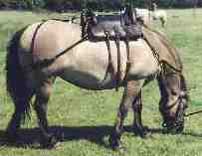Highland Pony
N/A
Fri, 11th April, 2025 - 11:07 pm GMT
Sponsor Ads:

Alternative Name
N/ABasic Info
The Highland Pony stands about 13hh to 14.2hh (52-58 in.) with some ponies - usually geldings- occassionally growing taller than this due to better feeding and care from birth. They are heavily built - 450/550kg for an adult - and although called 'ponies' are more like horses with short legs. They are the largest of Britain's nine native pony breeds. Today, nearly all Highlands grow up with primitive marks - 'eel' stripe along the back, shoulder stripes, 'zebra' stripes on the legs, with dark mane, tail and legs. These fade with time if the coat is gray. They are the only British native ponies in which all these markings occur so frequently, as a matter of course, without any conscious selection. This could suggest an ancient origin, as Highlands have had no selective breeding for color and limited 'improvement' in conformation through cross-breeding, apart from selection for greater size in the past. Unlike some other native breeds Highland ponies do not have to pass a subjective assessment of conformation or height before they are entered in the Stud Book - a pure Highland pony pedigree is all that is needed. One exception to this: white markings are not liked as possible evidence of cross-breeding in the past, and Highland stallions cannot be registered if more than a small white star is present. There are no narrow 'breeding schemes' in operation - for example, the use of 'approved' or 'selected' stallions - so Highlands retain a broad genetic mix within the population. The effect of this is that Highlands are quite variable in height, color and looks. The ponies today are an outcome of their whole genetic past, and not a breed created to some conceptual 'type'.
Health
N/AHabitat
N/ABehavior
Use : Saddle, pack, harness. It is often used from trekking to pack work. The Highland is sensitive and intelligent. The Highland pony or garron - a Gaelic word - was traditionally a crofter's (small farmer's) horse which could do all the work on the crofts in the highlands of Scotland. Before the coming of good roads 200 years ago, their use was as pack animals for transport and working the land. They were also used to pull carts and other wheeled vehicles. For the last 170 years Highland ponies have been the main means of transporting deer and other game off the hill, using special pack saddles, as well as many other jobs on the Scottish sporting estates. Pony trekking was begun in Scotland in 1955 using Highland ponies because of their quiet nature and ability to carry weight. Today the Highland still is used for its' traditional job on the hill, plus all kinds of riding and driving. Highlands make an ideal all-round family pony, able to tackle most things but not specialist in any. For example, they can be keen jumpers up to say four feet and will tackle long-distance riding or cross-country courses of medium length and difficulty. Where they do excel is in their ability to carry the heaviest load or person over the roughest and steepest ground. They have an inbred sure-footedness on hill slopes, which can well exceed the nerve of their rider. And doing all this while living outside no matter what the weather. Highlands generally dislike being stabled. Many still work on the sporting estates, packing loads or dragging timber, and are probably the commonest pony used for trekking in Scotland.Origin
ScotlandHistory
The Highland Pony is the native horse of the mountain areas of Scotland. (Scotland was once a separate kingdom to the north of England, but signed a treaty with England in 1707 to form the 'United Kingdom of Great Britain and Northern Ireland'). It is not certain if wild horses spread into Scotland after the retreat of the last glaciers around 10,000 years ago, or if the first ones were brought with prehistoric settlers. In any case, horses were present in Scotland by at least the 8th century BC. The horses/ponies used in Pictish times (about 550-800AD) in East and Northern Scotland, and shown on their carved stones, presumably passed on genetic input to today's Highland pony. Few relevant early records exist for the Highlands of Scotland, but we find Highland ponies described in the first travel accounts and agricultural surveys in the 18th century. The ponies then were smaller due to the harsh conditions under which they lived. Most present-day Highland pony bloodlines are traceable back to the 1830s. Although referred to as a 'breed', and since at least the 1880s bred through a studbook, Highland ponies were never created by controlled breeding in the way of other commercial breeds of livestock. They are descendants of the crofters' ponies used in the Scottish Highlands. Additions of course, happened with horses brought by invading armies, some crossing with other breeds, which applies to all native horses/ponies in the United Kingdom. There are an estimated 5,000 to 6,000 Highland ponies worldwide, mainly in Scotland, but numerous also in England, with a few elsewhere in the British Isles. France has a population of perhaps 500, Germany around 300, Australia 200, and smaller groups in Belgium, The Netherlands, Canada and elsewhere. A few have been imported into the USA, but so far not kept as a separate breed. A Highland stallion called Glenfiddich was imported to the King Ranch, Texas, in the 1950s to give a heavier back end to the quarter horses, but his records cannot now be traced, or any of his stock.Common Foods
grassSponsor Ads:
The trouble with born-again Christians is that they are an even bigger pain the second time around. --Herb Caen
Highland Pony
Coded by: BGID® | ALL RIGHTS RESERVED Copyright © 2000-2025
Disclaimer | Privacy | Report Errors / Contact | Credits
















